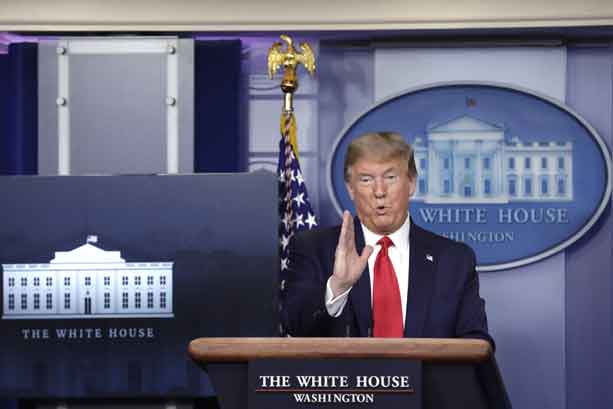 Abaca Press
Abaca Press
But on Saturday evening, when asked about rallies that violated social distance guidelines, Trump said he was "getting along very nicely with the governor of Michigan," Gretchen Whitmer, a Democrat, but wished she had not added "all these crazy things" to stay-home orders; restrictions on some travel and gardening sales had been especially controversial.
On a Trump campaign Web broadcast, conservative activist Charlie Kirk said Whitmer had "gone so far beyond the CDC guidelines to institute the most draconian, nonsensical and unneighborly rules," before pivoting to a topic that demanded more time: House Democrats' refusal to quickly fund more small-business grants without conditions.
The "reopen" protests, which have ranged from in-person gatherings of a few dozen to a few hundred people, were promoted by conservative media and local Republican parties, echoing the tea party protests that helped polarize public opinion on the Obama administration's economic policies 11 years ago. Those protests were initially designed to target both major parties, at least rhetorically, while these protests have featured bold pro-Trump messaging.
But channeling populist anger into his own campaign, something Trump did instinctively and powerfully four years ago, is not coming as easily to a president whose reelection could depend on the speed of national recovery.
"I'm frustrated [and] I wish I had someone to protest," Maryland Gov. Larry Hogan, one of the Republicans who has faced anti-stay-home protests, said on CNN's "State of the Union" on Sunday. "But I don't think it's helpful to encourage demonstrations and encourage people to go against the president's own policy. . . . The president's policy says you can't start to reopen under his plan until you have declining numbers for 14 days, which those states, and my state, do not have."
Trump campaign hats and flags have popped up at the events, and local Republican groups have helped organize and promote them. Alex Jones, a conspiracy-minded Trump supporter, helped organize a "You Can't Close America" rally in Texas; his website sells T-shirts that redesign the state's unofficial "Come and Take It" flag, replacing the Battle of Gonzales cannon with three rolls of toilet paper. Democrats, perpetually nervous about the president's instincts, believe he might throw his weight behind an unpopular cause.
"These protests may be a crystallizing moment in this pandemic, but not in the way Trump thinks," said Jesse Ferguson, a spokesman for the Democratic Congressional Campaign Committee during the 2010 tea party backlash. "At the start, it wasn't clear that one party would position as combating this virus, and the other would position as supporting its spread. But these protesters have put Trump in exactly that position."
The president has said little about individual states' policies, which are frequently operating on the same timeline as the White House's - to be revisited at the end of April. Asked whether the Trump campaign supported any particular protests, a spokesman deferred to the president's comments.
By Sunday afternoon, the president, reacting again to Fox News, would criticize only Democrats who worried about him moving too quickly to lift restrictions: "If I took even a little more time, they would loudly chant that I am moving too slowly."
When the protests began, many Democrats and Republicans thought first of the tea party movement, the last real effort, during an economic downturn, to get conservative activists in the streets. But Trump approached the tea party cautiously, too. He did not speak at one of its events until 2011, when he was exploring a presidential bid that he eventually decided against. "They're great," he said of the protests, "because they made Washington start thinking." Still, he was interested in the activists' energy only after they'd become winners.
The president has spoken more confidently about the logistical response to the virus, the first issue that put him at odds with governors. His campaign has focused more on the Chinese government's initial misinformation about the virus, more confident in that issue as a trap for Democrats. And Trump's allies see an opportunity as the economy founders and House Democrats tussle with the administration over the contents of the next rescue package for businesses.
Newt Gingrich, who frequently spots issues for the president to use to his advantage, pointed to a potential opening: House Speaker Nancy Pelosi's interview with a late-night host, in which the wealthy California Democrat showed off the gourmet ice cream getting her through the crisis.
"Where is former Vice President Joe Biden?" Gingrich asked in a Fox News column. "Does he support the job-killing, ice cream-eating liberal Democrats?" Here was more immediacy, and fewer risks, than the social-distance-flouting protests.
Sign up for the daily JWR update. It's free. Just click here.
(COMMENT, BELOW)


 Contact The Editor
Contact The Editor
 Articles By This Author
Articles By This Author